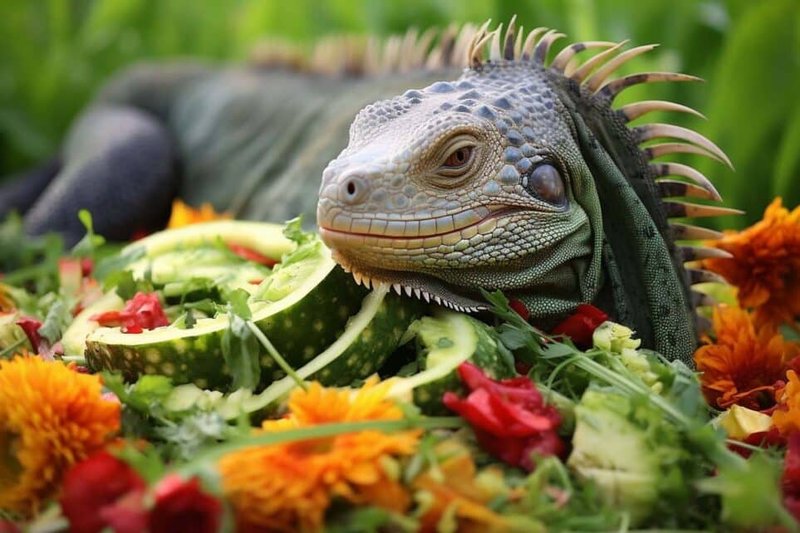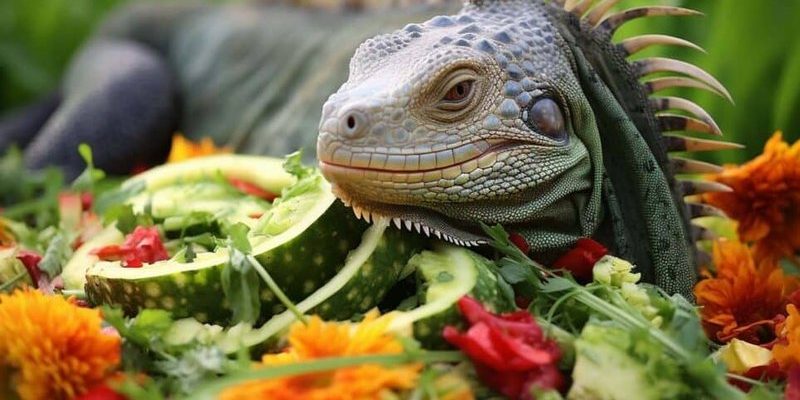
Imagine being in a vibrant jungle, where iguanas are the ultimate chillers, often hanging out among the trees. They feast mostly on plants and veggies—the kind of stuff you might find in a healthy salad. So, let’s dive into how these cool reptiles find their food, what they like to munch on, and how their hunting strategies work!
Understanding Iguana Diets
When talking about what iguanas eat, it’s essential to know they are generally herbivores. This means their meals usually consist of leaves, fruits, and flowers. In the wild, iguanas tend to munch on a variety of plants. Here’s what they love most:
- Leafy greens: Iguanas enjoy collard greens, dandelion greens, and kale.
- Fruits: They often go for bananas, mangoes, and figs, adding the sweetest touch to their diet.
- Flowers: Hibiscus and other colorful blooms are also part of their menu, providing both nutrition and beauty.
While their palate is primarily herbivorous, some iguanas—especially young ones—may occasionally munch on insects or small animals. This behavior is not as common and is more about survival than a regular eating habit. If you’ve ever seen one darting after a bug, you might think, “Why not? A little protein never hurt anyone!”
How Iguanas Find Their Food
Iguanas are equipped with some nifty skills when it comes to finding food. They’re like small, scaly foragers in the wild. Here are some key tactics they use:
1. Climbing Skills: Iguanas are excellent climbers. Their strong limbs and tails help them navigate trees and bushes in search of edible leaves. You might say they’re nature’s little acrobats, expertly balancing as they reach for the freshest greens.
2. Color Vision: Did you know that iguanas have excellent color vision? This ability helps them spot ripe fruits and vibrant flowers among the greenery. Imagine seeing the world in vivid colors; that’s the advantage iguanas have while hunting for lunch.
3. Scent Detection: Their keen sense of smell also plays a big role. Iguanas can sniff out tasty treats from quite a distance. When they catch a whiff of something delicious, it’s like a dinner bell ringing, and they’re off to investigate!
The Role of Habitat in Iguana Diet
Iguanas thrive in tropical and sub-tropical regions, which means they have access to a wide variety of plants. The lush environments where they live support their herbivorous diet. Here’s how habitat influences what they eat:
– Availability of Plants: In rainforests, iguanas can feast on an abundance of different plants. The more plant varieties available, the more diverse their diet can become. Think of it like a buffet of nature!
– Seasonal Changes: Just like you might enjoy seasonal fruits and veggies, iguanas adapt their diets based on what’s available. During certain seasons, they might switch their preferences as different plants bloom and bear fruit.
– Environmental Factors: Weather patterns also play a role. Droughts can make food scarce, forcing iguanas to travel further to find sustenance. When food is low, they become more opportunistic in their feeding habits.
Hunting Strategies of Iguanas
While iguanas mainly nibble on leaves and fruits, they do have a few clever strategies when it comes to hunting down their food. Let’s break down how they do this:
1. Stealthy Approach: When iguanas want to grab a snack, they often move slowly and cautiously to avoid drawing attention. This stealthy behavior helps them sneak up on their preferred food items.
2. Using Their Tongue: Iguanas have long, sticky tongues that function like built-in forks. They can flick their tongues out quickly to snatch leaves or fruits from branches. Watching this in action is like seeing a clever little tool in play.
3. Observation: Iguanas spend a lot of time watching their surroundings. By observing where other animals feed, they can scout new dining spots. It’s a bit like reading restaurant reviews before deciding where to eat!
Common Misconceptions About Iguanas’ Eating Habits
You might be surprised to learn that there are some myths about what iguanas eat. Here are a few common misconceptions:
- All Iguanas Eat Meat: Many people think iguanas are carnivorous, but they primarily eat plants. While a few might hunt for insects, it’s not a regular part of their diet.
- They Can Eat Any Plant: Not all plants are safe for iguanas. Some common household plants can be toxic. An iguana’s diet needs to be carefully curated to avoid harmful substances.
- Feeding Them Only Lettuce is Okay: Many pet owners mistakenly think lettuce is a suitable main food. In reality, it has little nutritional value for iguanas. A balanced diet is crucial for their health.
Understanding these misconceptions can help you take better care of pet iguanas or just appreciate their natural habits a bit more!
Iguanas are truly fascinating creatures, with unique diets and clever hunting methods. Understanding what iguanas eat and how they find their food provides a glimpse into their world. Next time you spot one, you might just think of them as charming little gardeners of the jungle, nibbling on nature’s finest plants.
Whether you’re a seasoned reptile enthusiast or a curious beginner, knowing about iguanas can deepen your appreciation for these incredible reptiles. So, keep an eye out for these leafy munchers next time you’re in their territory—you never know what delicious snack they might be hunting for!

